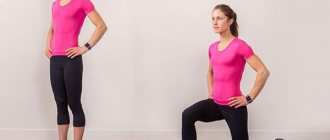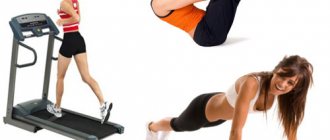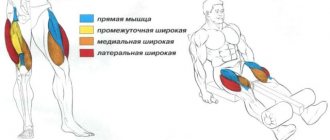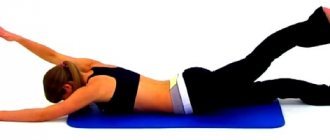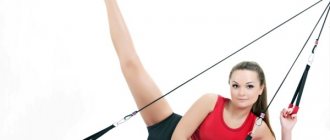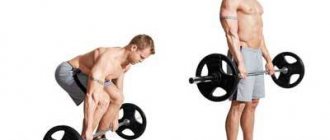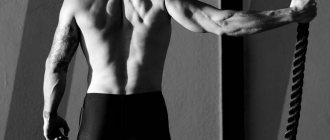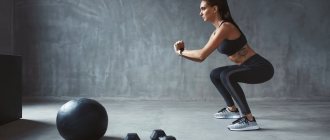If you are looking for the best exercises for your legs and buttocks, this post will come in handy. Here is a selection of ten effective exercises for training the gluteal muscles and thighs. Exercises will help pump up these muscles and improve their shape.
These exercises are equally suitable for both men and women. And, may the ladies forgive me, I will personally demonstrate all this! :) After all, usually in articles about exercises for legs and buttocks we see exclusively beautiful girls. I guess that's not a problem! After all, it is much better if a professional trainer shows you the exercises and does it really correctly. And you can always gawk at fashion models on Youtube! Here we train for results, and highly value our time and effort.
Exercises for legs and buttocks. Which ones are really the best?
There are a lot of exercises for the gluteal muscles and legs. But are they all good? And do you need everything? There are a lot of very stupid and downright useless moves. They often look impressive, but they are of almost no use. We will do real, effective exercises. The ten exercises below are truly the best of the best.
Here are the main signs of properly selected exercises for the muscles of the legs and buttocks.
The exercise for the buttocks should have a wide amplitude
Be sure to use exercises in which the muscles of the buttocks are stretched quite strongly and contracted almost completely. Squats and lunges are ideal for this.
The muscles of the legs and buttocks need to be trained from different angles
For good shape of the muscles of the legs and buttocks you need variety. There should be several exercises, not just one or two. These exercises should be loaded in different ways, in different body positions and in different planes. Your leg and butt training program should include squats, lunges, and various leg swings.
It must be possible to increase the load
And not just the number of repetitions! This is extremely important so that you are able to do each repetition with an increasing load. Ideally, this rule corresponds to exercises with dumbbells and a barbell, and on some exercise machines. Simply increasing the number of repetitions does not build muscle or improve the shape of your butt. However, high repetitions help dry out the body.
Exercises for legs and buttocks should not be isolated
Isolated exercises are exercises in which only one joint is worked. Such exercises are definitely needed. But in limited quantities. Much more important and productive are multi-joint exercises, in which, in addition to the buttocks, the hips and other muscles are worked. Therefore, try to ensure that the exercises you choose are multi-joint: squats, lunges, leg presses, etc. But there shouldn’t be too many different leg swings and knee extensions and bendings on the machines.
Exercises for legs and buttocks require an arched lower back
This is one of the most important rules that for some reason no one talks about. If you bend at the waist during squats, rest assured that you will not have any elastic and pumped up buttocks! The back should be arched in the lumbar region. This provides a wide range of movements and, accordingly, increased development of the buttock muscles. Well, and, among other things, it will strengthen the back muscles, improve posture and protect against back pain.
Flexibility is important
Training the muscles of the legs and buttocks requires increased flexibility. It is important to understand that developing flexibility will help improve muscle shape. And proper training of the legs and buttocks always improves flexibility. One helps the other!
Now let's move on directly to exercises for the gluteal muscles and legs.
Exercises for the back surface (biceps) of the thigh[edit | edit code]
The biceps are located on the back of the thigh and are involved in bending the knee.
Bodyweight exercises[edit | edit code]
- Lying leg raises
- Bridge
- Lying hip extension
- Lying leg raises
- Bridge
- Lying hip extension
Weight-bearing exercises[edit | edit code]
- Deadlift with a barbell on straight legs
- Romanian deadlift
- Deadlift
- Deadlift with a barbell on straight legs
- Romanian deadlift
- Deadlift
Exercises on simulators[edit | edit code]
The exercises are listed in order of decreasing effectiveness.
- Leg curls in the simulator
- Hyperextension
- Romanian deadlift on the Smith machine
- Deadlift with a barbell on straight legs in a Smith machine
- Lunges - low impact
- Leg curls in the simulator
- Hyperextension
- Lunges
Back lunges with dumbbells in hands
Back lunges with dumbbells in hands. Initial position.
Back lunges with dumbbells in hands.
Finish. Execution: Take dumbbells in your hands and stand straight. Take alternate steps back with your left and then with your right foot. Moving your leg back, squat on the other leg. This is a lunge. At the same time, tilt your body forward and try to bend at the lower back, without slouching. This allows you to properly stretch and feel the gluteal muscle. Take a deep breath as you lunge. When returning to the starting position, exhale. Do at least 2-3 sets of 10-15 repetitions (on each leg). Gradually increase the weight of each dumbbell. It’s normal for a woman to do lunges with 10-12 kg dumbbells, and a man to do lunges with 25-30 kg dumbbells.
The exercise develops the buttocks and quadriceps muscles of the thighs. Improves flexibility.
Learn more about the exercise - backward lunges with dumbbells in your hands.
How to properly perform a circuit complex
- “Circles” of static exercises should be repeated every other day, alternating them with training of any other type, but preferably aerobic or stretching (or you can alternate both).
- The primary complex for weight loss is designed for 2-3 months (depending on your individual characteristics, as well as on how correctly you create a psychological mood in yourself, adjust your diet, water balance, and alternating training with rest, and of course from your initial condition!).
- After completing the course, you should replace it for six months, for example, with daily aerobic training (can be alternated with stretching training), and then conduct at least another 2-3 month course of static exercises to consolidate the result.
- The number of “circles” increases as you progress: in the first week - one, in the second - two, in the third - three, and so on. At a minimum, this figure should be brought to 4-5.
- Before starting the exercises, you need to do a warm-up (vigorous walking in place, then running or jumping rope until the muscles are well warmed up).
- Between laps it is very important to do small stretching warm-ups.
- During exercises, it is necessary to monitor the correct breathing, do not hold it, do not knock it down (for the correct process of blood supply and oxidation in the muscles).
- After a repeated course of consolidation, you can alternately include certain exercises in complexes of exercises, which can be performed no more than 2-3 times a week. Our wise body, taught by the previous intensive, will “get it” on its own on the remaining days.
Squats
Squats. Initial position.
Squats.
Finish. Execution: You will need racks and a barbell. You need to take the barbell from the racks onto your shoulders and take a step back. Feet shoulder-width apart or wider. Socks are slightly apart. Perform fairly deep squats while holding the barbell on your shoulders.
Pay attention to an important detail about squats. You need to start each squat by slightly moving your pelvis back, and not immediately by bending your knees. And it’s normal if you lean forward quite a lot during squats. This is part of proper squat technique. When bending your legs, take a deep breath, when extending your legs, exhale. Do at least 3-4 sets of 12-15 squats.
As a guide, the working weight on the barbell for women is around 50-60 kg. For men – 100 kg and above. But these working weights must be approached gradually, starting literally with an empty bar.
The exercise develops the muscles of the buttocks, the quadriceps muscles of the thighs (front of the thigh), and the biceps of the thighs (back of the thigh).
You can learn more about this wonderful exercise here - back squats.
Basic exercises[edit | edit code]
Basic exercises for legs and buttocks
- Squats
- Romanian Deadlift (Stiff-Legged Barbell Deadlift)
- Goblet squats
- Lunges (for example, Barbell Walking Lunge; Barbell Reverse Lunge)
- Sumo deadlift
- Plie squats
Isolation exercises
- Single leg press
- Bridges (lying hip raises - Barbell Hip Thrusts) with different weights
- Bulgarian Split Squats
- Smith machine squats with legs forward
- Leg extension (on a block)
- Leg abduction to the side (on a block)
King's deadlift
King's deadlift. Start.
King's deadlift.
Finish. This is a luxurious variation of the one-leg squat that even the most untrained person can handle.
Execution: stand straight, feet together. Take a small step back with your right foot, but place the bulk of your body weight on your left. Now bend both legs at the knees and squat, trying to reach the floor with your fingers or even palms. At the same time, be sure to ensure that your back does not round. A rather strong forward bend is inevitable, which is precisely what engages the buttock muscles.
Then vigorously straighten your legs and stand in the starting position. Repeat at least 10-15 times. Then switch legs and do the same number of repetitions. Essentially, you squat on your “front” leg while resting your “back” leg lightly on the floor. Touching the floor with your hands helps you maintain your balance.
Perform at least 2-3 sets of 10-15 repetitions. If the exercise seems easy enough, you can pick up dumbbells.
The King row perfectly develops the muscles of the buttocks and quadriceps muscles of the thighs. The buttocks bear the main load.
More details about the exercise - King deadlift.
How to quickly pump up your butt
In an effort to achieve results in pumping up the lower body, athletes often forget about the basic rules for building a muscle corset in general. This is about:
- preliminary disposal of excess subcutaneous fat;
- adherence to the principles of healthy eating;
- eliminating bad habits from your usual lifestyle;
- formation of a daily routine (eating, playing sports, getting up and going to bed should occur at the same time every day);
- regular physical activity.
Such lifestyle adjustments will not become a problem for the athlete, only if there is great motivation and desire to change his body for the better. Psychologists recommend setting mini-goals for yourself at the beginning of the transformation journey, for example, going without sweets for 3 days. Their achievement will have a positive effect on the human psyche and stimulate him to further work on himself.
Another option for motivation could be the spirit of competition. The process of strengthening the buttocks can be started together with a friend who has similar goals and initial parameters. The desire to become the best will play into the hands of the athlete who ultimately wants to get the body of his dreams.
When pumping up your butt, it is important to keep in mind the features of narrowly focused training and avoid making the most common mistakes that can lead to the opposite result. These include:
- incorrect selection of working weight;
- same type of repetitive exercises (for example, daily squats with a barbell included in a training program designed for the whole week);
- using exclusively power loads with weights;
- daily training.
Important! The above mistakes can not only interfere with achieving results from sports and cause serious injuries, but also provoke intense burning of muscle fibers. This phenomenon will most likely provoke loss of muscle mass in the buttocks and sagging skin.
Be sure to check out:
How to properly squat for a girl to pump up her buttocks: the best exercises 8 of the most effective exercises for the buttocks for girls at home and a 4-week pumping program Taking a course to Brazil: pumping up the buttocks and thighs Pumping up the legs at home: exercises for girls
Spreader
https://youtu.be/KFJc4VveuKc
This is the coolest exercise for the buttocks. It is on it that you will feel how the gluteal muscles are literally burning and begging for mercy! Standing also develops the muscles of the legs and waist, and is a great workout for the heart. True, the exercise is also quite difficult, not for beginners.
Execution: Take a stable lunge position. Hands on the waist. Push both feet strongly off the floor and, jumping, change the position of your legs to the opposite. If at first the left leg was in front, then after the jump it should be behind.
Perform at least 2-3 sets of exercises with 12-20 jumps each.
Learn more about the exercise - stretching.
Content
- 1 Features of training the buttocks and legs in women
- 2 Basic exercises
- 3 Exercises for the buttocks 3.1 Exercises at home
- 3.2 Weight training
- 3.3 Exercises on simulators
- 3.4 Exercises for the gluteus medius and minimus
- 4.1 Bodyweight exercises
- 5.1 Bodyweight exercises
- 6.1 Bodyweight exercises
- 7.1 Bodyweight exercises
Hyperextension
Hyperextension. Hands behind your head.
Hyperextension.
Hands behind your head. Hyperextension is usually suggested as an exercise to strengthen the back. But this is also a great exercise for the buttocks and the back of the thighs! Especially if you do it with extra weight.
Execution: take the starting position on the simulator. Pick up a small weight plate or dumbbell. Or just put your hands behind your head. Raise and lower your body over a wide amplitude. Exhale when lifting your body, inhale when lowering.
Try to feel how the muscles in the back of your thighs and buttocks work.
About the exercise in more detail - hyperextension.
Build muscles with professionals
If you want to independently organize training aimed at pumping up the buttocks and lower extremities, it is extremely important for the athlete to study the opinion of qualified professionals on this issue.
Ivan Zimkin, fitness trainer
Ivan recommends that beginners avoid including exercises with heavy weights in their training program. In addition to the danger of serious injury, the athlete can thus start the process of burning muscles rather than tone them, for example. To competently construct an algorithm for the struggle for an ideal figure, according to Ivan, it is extremely important to study the physiology of your own body and increase physical activity as the muscles get used to it, and not from the moment of the first lesson.
Yulia Dvilina, fitness trainer
Julia believes that achieving a beautiful butt and legs with a properly structured training regimen will be easy for both women and men. She advises her clients to spend as much time as possible on basic exercises, in particular squats, lunges, and deadlifts. It is this kind of training, according to Yulia, that can help an athlete achieve his goal in the shortest possible time.
Yuri Moskvin, fitness trainer
Yuri considers it extremely important for effective pumping of the lower extremities and buttocks to perform a warm-up and cool-down before and after training, respectively. This habit will properly influence the growth of muscle fibers in the target areas. In addition, by following this recommendation, the athlete minimizes the risk of serious injuries, such as sprains, ruptures, cracks, and so on.
Leg raises while standing on all fours
Leg raise while standing on all fours. Start.
Leg raise while standing on all fours.
Finish. This exercise is isolated. But it very effectively tones the muscles of the buttocks. Complement them with squats and lunges.
Execution: get on all fours, stretch one leg back. Smoothly raise and lower this leg in a circular path. Your foot should describe a semicircle when viewed from the side. Perform 2-3 sets of 12-20 lifts with each leg. It is important not to help yourself with movements of the waist, as this significantly reduces the effectiveness of the exercise for the gluteal muscles. Exhale when raising your leg, inhale when lowering it.
Leg raises are excellent for toning, lifting and improving the shape of the buttocks.
Muscles of the legs and pelvis[edit | edit code]
| Name | Which joints are controlled? | Start | Ending | Action taken |
| Calf muscle | Ankle and knee | Condyles at the bottom of the femur | Posterior surface of the calcaneus | Plantar flexion of the foot, flexion of the knee (to a lesser extent) |
| Soleus muscle | Ankle | Upper two-thirds of the posterior surface of the tibia and fibula | Posterior surface of the calcaneus | Plantar flexion of the foot |
| Rectus femoris (part of the quadriceps femoris) | Hip and knee | Anterior inferior part of the iliac spine of the pelvis | Patella (kneecap), tibial tuberosity (via patellar ligament) | Flexion at the hip joint, extension at the knee joint. In addition, the rectus femoris muscle is involved in turning the leg outward. |
| Vastus lateralis, vastus intermedius, vastus medialis (part of the quadriceps femoris) | Knee | Outer, anterior and inner surface of the femur | Patella (kneecap), tibial tuberosity (via patellar ligament) | Extension |
| Posterior thigh muscles: short and long heads of the biceps femoris, semitendinosus and semimembranosus (usually act as one muscle) | Hip and knee | Short head of the biceps femoris: inferior part of the linea aspera of the femur and lateral intermuscular septum. Other muscles: ischial tuberosity. | Biceps femoris: head of the fibula and lateral condyle of the tibia; semitendinosus and semimembranosus muscles: medial tibial condyle | Extension at the hip joint, flexion at the knee joint. In addition, the semitendinosus and semimembranosus muscles are involved in inward rotation of the leg. |
| Thigh adductors: pectineus, adductor brevis, adductor longus, adductor magnus, gracilis (usually act as one muscle) | Hip joint (gracilis muscle also goes around the knee joint) | Pubic and ischial bones of the pelvis | Lesser trochanter of the femur, linea aspera and medial epicondyle of the femur. Gracilis muscle: superior medial surface of the tibia | Mainly casting |
| Tensor fascia lata | Hip | Anterior superior iliac spine | Iliotibial tract | Abduction and flexion, partially internal rotation |
| Gluteus maximus muscle | Hip | Posterior iliac crest, sacrum and thoracolumbar fascia | Iliotibial tract | Extension, external rotation |
| Gluteus medius and minimus (abductor muscle group) | Hip | Outer surface of the ilium | Greater trochanter of the femur | Abduction, external rotation (gluteus medius), internal rotation (gluteus medius and minimus) |
| Iliopsoas muscle | Hip | Inner surface of the ilium, base of the sacrum, last thoracic and five lumbar vertebrae | Lesser trochanter of the femur | Flexion |
| Hip rotators: piriformis, superior and inferior gemellus, obturator externus and internus, quadratus femoris | Hip | Anterior surface of the pubis, posterior surface of the ischium, obturator foramen | Upper and lower parts of the greater trochanter of the femur | Outward rotation |
| Note . Other important leg muscles not listed in the table for the sake of simplicity include the tibialis anterior and posterior, peroneus, and sartorius. The latissimus dorsi, trapezius, rhomboids, erector spinae, and quadratus lumborum muscles will be discussed in detail in the article Back and Shoulder Exercises (for Women). | ||||
Gluteal bridge
Gluteal bridge. Start.
The glute bridge is an exercise for the buttocks and the back of the thighs, performed in a lying position.
Execution: lie on the mat, bend your knees and place your feet firmly on the floor. The distance between the feet is 10-20 cm. Raise and lower the pelvis, actively working the muscles of the buttocks. You will probably feel not only your buttocks, but also the back of your thighs. When lifting your pelvis up, exhale, when lowering, inhale. Perform at least 3 sets of 20-30 repetitions. If the exercise is too easy, place a barbell plate or dumbbell on your lower abdomen. For example: in this exercise we often use a weight of 25-35 kg for 20 repetitions. So don't waste your time!
The glute bridge perfectly develops the buttocks! : )
Read more about the gluteal bridge. See also single leg glute bridge.
Hips and Butt Workout: Round 1
The first round of the thigh and butt workout lasts approximately 10 minutes. You will find 7 exercises that are repeated in two circles. You can rest for 30-60 seconds between circles. Exercises are performed according to the scheme 30 seconds of work / 10 seconds of rest. Can be performed without a timer, counting the number of repetitions.
The first round includes the following exercises:
- One-two squats: 12 reps (30 seconds)
- Pulse Lunges: 10 reps (30 seconds)
- Alternating leg swings to the side: 20 repetitions (30 seconds)
- Plie squat calf raises: 18 reps (30 seconds)
- Leg kick back: 20 reps (30 seconds)
- Half squat walk: 8 walks (30 seconds)
- Cross Lunge: 12 reps (30 seconds)
In the first circle we perform exercises on the right leg, in the second circle on the left leg.
1. One-two squats
Why: Squats are one of the best exercises for toned buttocks and thighs. In this exercise, it is very important to tense the gluteal muscles at all phases of the exercise for proper loading.
How to do it: Stand straight, feet slightly wider than shoulder-width apart, toes turned slightly outward, arms folded in front of you. Lower your pelvis down, bending at the hip joints and slightly tilting your body forward. On the count of “one,” hold for 2 seconds in a half-squat position. On the count of two, lower your pelvis until your thighs are parallel to the floor. Hold the squat position for 2-3 seconds, then return to the half-squat position and the starting position. During squats, do not round your lower back or bring your knees forward of your toes.
Lighter version: Do not lower yourself to parallel with the floor, stop in a semi-squat position.
How long to do: 12 repetitions or 30 seconds.
2. Lunge in place with pulsation
Why: Lunges are a key exercise for effectively training your thighs and buttocks. They include the quadriceps, hamstrings, and gluteus maximus muscles. Moreover, the further you move your back leg during a lunge, the more load your buttocks receive. We will make the exercise more challenging by using pulsation, which adds stress to all target muscles.
How to perform: The starting position of this exercise is the left leg set back about a meter, the knees are slightly relaxed, the arms are folded in front of you or rest on the waist, the abs are tense, the back is straight. Keeping your body straight, do a squat with both legs bent at the knee joint. The knee of the back leg is a few centimeters from the floor, the knee of the front leg does not extend beyond the toe, there is a right angle between the shin and thigh of both legs. Having lowered yourself into a lunge, hold for a couple of seconds, make springy movements for 3 counts and return to the starting position.
Lighter version: Hold on to a chair to maintain balance, you can do a regular lunge without “springs”.
How long to do: 10 repetitions or 30 seconds. In the second round, perform this exercise on the other leg.
3. Alternating leg swings to the side
Why: Leg swings help to engage all the muscles of the lower body, but especially the buttocks and adductor muscles of the legs. This exercise is also great for getting your heart rate up for extra calorie burning while training your thighs and buttocks.
How to do it: Stand up straight, back straight, stomach tucked. As you exhale, make a sharp swing with your right leg to the side until your leg is parallel to the floor or slightly higher. As you inhale, lower your leg and, without staying long in the starting position, lift your left leg up in the same way. During swings, do not pull your toes up, maintain tension in the abdominal muscles, and keep your buttocks taut.
Lighter version: Do not raise your leg too high, you can hold on to the chair.
How long to perform: 20 repetitions (i.e. 10 repetitions on each side) or 30 seconds.
4. Plie squat raise
Why: This exercise is great for working the leg muscles, especially the inner thighs, quadriceps and calf muscles. Your muscles will not relax even for a second due to the fact that you will continuously be in the plie squat position.
How to do it: Stand in a plie squat position - open your hip joints, spread your legs as wide as possible, knees pointing to the sides, arms folded near the chest or at the waist, body straight. Rise onto your toes, lifting your heel off the floor. At the top point, the foot is almost perpendicular to the floor. Tighten your buttocks and legs, feel a pleasant burning sensation in the inner thigh area.
Lighter version: Rise onto your toes alternately with one leg and the other.
How long to do: 18 repetitions or 30 seconds.
5. Taking the leg back
Why: This seemingly simple exercise perfectly works the buttocks and hamstring muscles. In addition, to maintain balance, the abdominal and back muscles are additionally involved in the work.
How to do it: Stand straight, legs slightly apart, toes turned outward, hands on your waist, stomach tense. Raise the shin of your right leg so that a right angle is formed between the shin and thigh. Bend the knee of your left leg slightly. This is the starting position. Slowly move your leg back, reaching your heel back and up. The body remains stable and does not lean forward. Hold for 2-3 seconds, then return to the starting position. Feel how the muscles of the buttocks and hamstrings work.
Lighter version: Use your hands on a chair or wall to maintain balance, without moving your leg too far back.
How long to do: 20 repetitions or 30 seconds. In the second round, perform this exercise on the other leg.
6. Walking in a half-squat
Why: This dynamic exercise will not only work your glutes, quads, and outer thighs, but will also raise your heart rate for extra calorie burn during a thigh and glute workout.
How to do it: Lower yourself into a half-squat position with your arms folded in front of you. Take 3 steps to the side, about half a meter each, maintaining a half-squat position. Then take 3 steps in the opposite direction. Perform the exercise in continuous dynamics, the muscles of the legs and buttocks are tense, the semi-squat position is maintained throughout the entire exercise.
Lighter version: Don't go deep into a half squat.
How long to perform: 8 passes (i.e. 4 passes in each direction) or 30 seconds. One pass includes 3 steps.
7. Cross lunge
Why: Cross lunges help to “reach” the most problematic female areas: the outer and inner thighs, as well as pump up the gluteal muscles.
How to do it: Stand up straight, arms folded in front of you or on your waist, legs slightly apart, gaze directed forward. Step your right leg back, taking a large cross step back with one leg. Lower the knee of your back leg as low as possible without touching the floor. The front leg is bent at the knee so that the thigh is parallel to the floor and the shin is perpendicular to it. The knee does not go forward of the toe. Hold the lunge position for 2 seconds, then return to the starting position, keeping your back straight.
Lighter version: Cross your leg back, but don't lower yourself into a lunge. You can hold on to a chair to maintain balance.
How long to do: 12 repetitions or 30 seconds. In the second round, perform this exercise on the other leg.
Deadlift
Deadlift with dumbbells. Start.
Deadlift with dumbbells
Deadlifts are simple forward bends with straight legs and dumbbells in your hands.
Execution: Take dumbbells (or a barbell) in your hands and stand straight. Legs close to each other. There is about 10 cm between the feet. The feet are parallel. Gently lean forward until the dumbbells are slightly below your knees. Then straighten up vigorously and return to the starting position. Pull your shoulders back a little. Perform 2-3 sets of 12-15 inclines each. When bending over, inhale; when straightening your body, exhale.
Please note: deadlifts should not be performed with stiff legs. The knees are always slightly bent. But don't bend them too much when bending.
Deadlifts develop the muscles of the buttocks and the back of the thighs well, strengthen the back, improve posture, and develop flexibility. And don't be shy with the dumbbell weights! Women can do deadlifts with 10-12 kg dumbbells in each hand. And men - with dumbbells weighing 25-35 kg in each hand.
See also - deadlift with dumbbells.
Warm-up for hips and buttocks
In the warm-up you will find 10 exercises to warm up your joints, warm up your body and prepare your muscles for the upcoming load. This warm-up focuses on the lower body, so you can use it in other workouts for the thighs and buttocks. Warm-up exercises are performed for 30 seconds without rest between exercises. The total duration of the warm-up is approximately 5 minutes.
The warm-up includes the following exercises:
- Walking in place: 20 leg raises on each side (30 seconds)
- Body turns: 10 body turns in each direction (30 seconds)
- Leg bends: 8 body bends in each direction (30 seconds)
- Hip rotation: 5 clockwise and 5 counterclockwise rotations on each side (15 seconds on each leg)
- Knee rotation: 10 clockwise rotations and 10 counterclockwise rotations (30 seconds for the entire exercise)
- Foot Rotation: 7 clockwise and 7 counterclockwise rotations on each side (15 seconds per leg)
- Half squats: 15 reps (30 seconds)
- Half lunges: 10 lunges on each side (30 seconds)
- Knee Raises: 15 leg raises on each side (30 seconds)
- Jackie: 15 leg raises on each side (30 seconds)
Warm-up is performed continuously, one exercise replaces another without rest. After warming up, you can rest for 30-45 seconds before starting the main workout for the thighs and buttocks. To do this, walk in place at a slow pace, restoring your breathing, but under no circumstances sit down or lie down.
1. Walking in place
We begin our warm-up by walking in place. The arms are bent at the elbows and move in sync with the legs. Feel how your body warms up and your heart rate increases with this simple exercise.
How much: 20 leg raises on each side (40 steps total) or 30 seconds.
2. Body turns
Stand straight, feet wider than shoulder-width apart, arms out to the side. Perform body turns to the right and left without lifting your feet from the floor. Bring your shoulder blades together, twist using your spine, not your pelvis.
How much: 10 turns on each side or 30 seconds.
3. Tilts towards the feet
Stay in the position with your arms out to the side. Bend towards the floor, trying not to round your back and touching your hand to the floor. While bending, bring your shoulder blades together, try not to bend your knees. Feel the stretch in the back of your thigh.
How much: 8 bends in each direction (16 bends in total) or 30 seconds.
4. Hip Rotation
This simple exercise perfectly warms up the hip joints and helps avoid injuries and sprains during hip and buttock workouts. Stand up straight with your hands clasped together or at your waist. Lift the knee of your left leg towards your chest and begin to rotate your hip. The body remains motionless. Remember to perform the exercise by rotating your leg both clockwise and counterclockwise.
How much: 5 clockwise and 5 counterclockwise rotations on each leg or 15 seconds on each leg.
5. Knee rotation
This simple joint exercise helps to develop the knee joints well, which is especially important before training the hips and buttocks. Bend your legs, tilt your body toward your hips, and place your hands on your knees. Start rotating your knees to one side, keeping your legs together. Don't forget to repeat the rotation in the opposite direction.
How much: 10 clockwise rotations and 10 counterclockwise rotations or 30 seconds for the entire exercise.
6. Rotation of feet
Stand straight, hands shoulder-width apart. Raise your left leg up to approximately a right angle between your thigh and shin. Rotate your foot in one direction and the other, stretching your ankle. When performing this exercise, note that the movement is carried out only by rotating the foot, not the lower leg.
How much: 7 clockwise rotations and 7 counterclockwise rotations on each side or 15 seconds on each leg.
7. Half squats
Stand straight with your arms at your sides. Slightly tilting your body and bending your knees, lower your pelvis slightly down in a semi-squat position. Do not lower your buttocks too low, remember that these are only warm-up exercises. The arms move synchronously, joining together at the bottom of the half-squat. Always try to warm up with half squats before training your thighs and buttocks.
How much: 15 half squats or 30 seconds.
8. Half lunges with arm raises
Stand straight with your arms at your sides. Alternately move your right and left legs back, transfer your body weight to the front supporting leg, bent at the knee. At the same time as you move your legs back, raise your arms vertically, stretching your spine. Hold the half-lunge position for a couple of seconds before returning to the starting position.
How much: 10 half lunges on each side (20 half lunges total) or 30 seconds.
9. Walking in place with knees raised
We finish the warm-up with cardio exercises that warm up the body. Bend your elbows, place your forearms in front of you. Start walking in place, raising your knees up almost to a right angle with your body, touching your hands folded in front of you. Perform the exercise at a fast pace, warming up your body and raising your heart rate.
How much: 15 leg raises on each side (30 steps total) or 30 seconds.
10. Raising arms and legs
Stand straight, legs close to each other, arms at your sides, knees relaxed. Raise your arms through your sides, bringing them together above your head. At the same time, extend your right leg half a meter forward, touching your heel to the floor. Then return to the starting position and repeat on the other side. Perform the exercise dynamically, quickly changing sides. Hands move in full range.
How much: 15 repetitions on each leg (30 arm raises in total) or 30 seconds.
boat
Exercise boat. Start.
Exercise boat.
Finish. The boat is usually done to train the back muscles and improve posture. But it is also indispensable for the muscles of the buttocks!
Execution: lie face down on the mat, stretch your arms forward or along your body (it’s easier this way). Focus on tightening your butt muscles. Raise your arms, upper body and legs off the floor. Hold this position for a moment. Then gently lower your limbs to the floor. Perform 2-3 sets of 15-20 repetitions. When raising your arms and legs, inhale, when lowering, exhale. You can also try the reverse breathing order. Perhaps it will be more comfortable for you.
The boat perfectly develops the gluteal muscles, strengthens the back, and improves posture. Don’t forget to relax your back after the pump - lie on your back with your legs tucked to your stomach.
See also - boat.
Plie squats
Plie squats. Start.
Plie squats.
Finish. This is a useful and interesting form of squats with a wide stance.
Execution: stand straight and spread your legs wide. Literally 1 meter between the feet. Turn your socks slightly to the sides. Place your hands on your stomach as shown in the photo. Next, begin to bend and straighten your legs while doing squats. Try to spread your knees as wide as possible during squats. And squat deep enough. Try to keep your torso straight and vertical. When bending your legs, inhale, when straightening, exhale. The exercise is performed in 3 sets of 12-15 repetitions. You can make it more difficult by picking up dumbbells or a barbell plate.
Plie squats develop the muscles of the buttocks and inner thighs, improving flexibility like a split.
Exercises for the buttocks[edit | edit code]
The gluteus maximus muscles are well worked when performing basic leg exercises - squats, lunges and deadlifts. But for the medium and small bundles of the gluteal muscles, you need to perform special exercises - swinging your legs in a block device, or with leg weights. To fully work out the “minor” muscles of the gluteal region, you need to perform these exercises both in a standing position and lying on your side. Read more:
Pumping the gluteal muscles
Exercises at home[edit | edit code]
Basic exercises:
- Lunges without weights
- Lunges on a bench
- Squats with ball between legs
- Wall squats
- Lying leg raises
- Swallow exercise with a ball
Isolation exercises:
- Taking the leg back
- Shoulder bridge with raised arms
- Lying hip extension
- Lunges without weights
- Bench lunge option
- Squats with ball between legs
- Wall Squat
- Lying leg raises
- Swallow exercise with a ball
- Taking the leg back
- Shoulder bridge with raised arms
- Lying hip extension
Weight-bearing exercises[edit | edit code]
Basic exercises:
- Squats with a dumbbell lowered in front of you
- Forward bends with a barbell or “good morning”
- Deadlift
- Lunges with dumbbells/barbell
- Squats with dumbbells
- Squats
- Wide-legged barbell squats or plie squats
- Wall squats with weights
- Goblet squats
Isolation exercises:
- Leg extension with weights
- Shoulder bridge with raised arms with weights
- Lying hip extension with weights
- Squats with a dumbbell lowered in front of you
- Forward bends with a barbell
- Deadlift
- Lunges with dumbbells
- Lunge forward with one leg with a barbell on your back
- Squats with dumbbells
- Squats
- Wide-legged barbell squats
- Squat with a barbell on the shoulders “Plie”
- Wall squats
Exercises on simulators[edit | edit code]
Basic exercises:
- Lunge forward with one leg with a barbell
- Smith machine squats
- Hack squats
- Leg press on a machine with wide stance or Leg press for girls
- hyperextension
- Leg raises while lying on your stomach on a bench
Isolation exercises:
- Straight leg extension on a block in a standing position
- Single leg press
- Leg raises in the simulator
- Lunge forward with one leg with a barbell
- Smith machine squats
- Hack squats
- Single leg press in the machine
- Leg press on a machine or Leg press for girls
- Hyperextension
- Leg raises while lying on your stomach on a bench
- Straight leg extension at the hip joint on a block simulator in a standing position
- Leg raise on the simulator
Exercises for the gluteus medius and small[edit | edit code]
The gluteus medius and minimus muscles make virtually no contribution to the volume of the buttocks due to their small size.
- Leg abduction on a block
- Breeding legs on the simulator
- Leg raise while lying on your side
- Swing your legs while kneeling
- Pulling the leg to the side on a block
- Breeding legs on the simulator
- Leg raise while lying on your side
- Swing your legs while kneeling
